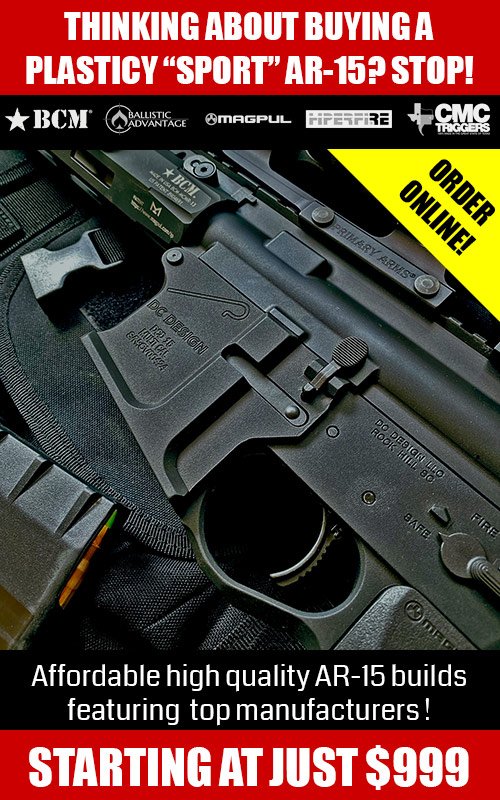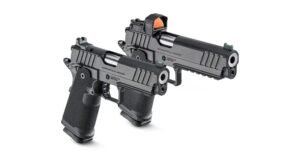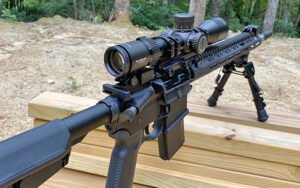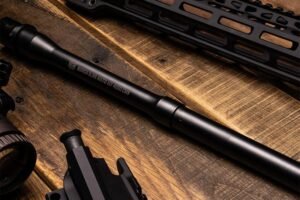First AR-15 Build? Here’s what You Need to Know
Planning Your AR-15 Build
Pick Your Purpose. Pick Your Budget. Pick Your Parts. In that order.
Obviously the reason(s) you want this AR-15 in the first place is going to drive the other considerations. AR-15s are vey modular, and AR components can vary wildly in price, depending on the style, purpose and manufacturer. Pistol or rifle? Hunting, tactical, recreation, competition? Standard or alternate caliber? Budget, mid-grade or high-performance. Or maybe all of the above!
All of these questions will help you determine what you’ll need for your build – or at least knowing the answers can help a professional who can then guide you on what might work best.
But one thing most have in common, is that we don’t want to spend more than we have to. So here are some tips to keep in mind when building on any budget.
1. You probably don’t need top-of-the-line.
Not all parts are created equal, and I’m sure many beginners look at different brands and wonder what makes one manufacturer’s component worth more than another? The old saying, “you get what you pay for” usually holds true, but there is a fairly steep rate of diminishing returns when it comes to cost vs performance.
What this means is that while higher-priced components will likely perform better than their cheaper counterparts, the ratio of money vs performance doesn’t climb at an equal pace. And it gets worse as things get more expensive. A $150 barrel may actually perform noticeably better than a $50 barrel, but a $400 barrel won’t give you anywhere close to the same level of upgrade over that same $150 barrel. If you’re shooting professionally at an elite level, you might need the tiny bit of extra potential that and additional $250 buys, but 99.9% of shooters would get the same results from the $150 barrel.
2. Sometimes a logo is just a logo.
There are many great manufacturers out there, but it may surprise some that most big-name brands do not fabricate every single part they sell. Many specialize in a specific set of parts, then purchase the rest from various OEM manufacturers – behind-the-scenes part-makers which specialize in making one particular part.
Often these OEM manufacturers are military suppliers, but part of their business model is selling to other manufacturers. The well-known brand does a bulk purchase at wholesale prices, with the OEM company engraving that brand’s logo to the parts. The brand then sells that part at a healthy price markup.
This can literally lead to situations where multiple brands are selling the exact same part for different prices depending on how they feel their brand name affects the value.
The trick here is that many of these OEMs sell their wares directly to the public under their own brand name for far less than big name brands are selling them for. While your part may not have that sexy logo etched on it, you’re getting the same performance for less money. Besides, these parts are often internal pieces that no one sees anyway.
3. Put your money where it counts.
This is especially important when planning budget builds. Spending a little more for one type of upgrade can make a world of difference while putting more budget towards another won’t make any.
In terms of their function, there’s zero difference between the $100 spider-branded lower receiver and a $40 horse brand. You can argue quality control and brand reputation make one more valuable than the other, but at the end of the day they are both built to the exact same mil-spec standards with the same material and have the same lifetime warranty.
So instead of paying extra for a logo, think about an after-market trigger or a better barrel. Those types of components will deliver actual performance enhancements instead of just a vanity upgrade .
4. Keep it real.
Imagine the following scenario: You and your friend are watching golf on TV. Suddenly, having never played before, your friend announces he wants to take up the sport. He heads directly over to the local pro shop and buys the most expensive set of clubs they have. When you asked him why he needed the most expensive set, he replies that he’ll need them when he eventually goes pro.
You’d probably think your friend had a screw loose, but many people approach their first ARs build the same way.
There’s no denying a shooter needs equipment up to the task, but it’s important to be realistic about your intentions. Everyone wants a gun that can do everything the bestest, but many times new builders tend to overbuild…which also tends to mean overspend.
So be honest with yourself how much you really intend to use your AR-15, and for what. We can’t count how many who’ve told us their build requires fancy upgrades because they plan to get into 3-gun, or want to use it to hunt. Of course they end up never following through. They’ve spent extra money for nothing.
So if those things are on your mind, we’ll just say this: most middle-of-the-road AR-15s will do just fine as a starter 3-gun rifle. And we’ll be happy to help you build that L33T, ultra-lightweight, super-accurate, zero-recoil race gun when you get to a level of competition where those things actually matter. By that same token, a $500 hunting rifle will out-shoot all but the most high-end ARs, and with better hunting caliber choices to boot.
Save your money and buy ammo instead. The performance of any firearm has much more to do with the skill level of who’s shooting it, rather than the components its made from. No super-top-of-the-line-ultra-uber-outfitted AR in the world is going to make up for lack of training. Someone who shoots regularly with a $500 AR-15 will out-shoot the guy with the $2000 “precision” safe queen all day long.
Starting the Build
The right tools for the job.
Make sure you have the correct tools. This one seems obvious, but many first time builders make the mistake of thinking they can get by with the basic everyday tools in their garage. This will only lead to a lot of headaches, busted knuckles, scratched anodizing and frustration. More importantly, an improperly assembled firearm is an unsafe firearm.
This is also an important budget consideration. While many common tools do double duty for AR building, there are a few specialized tools that you’ll want to have on hand. It’s going to defeat the purpose of saving money if it’s all going to be eaten-up buying the tools you need.
That being said, investing in good tools is a wise decision for any gun owner. Down the road you may need to repair a part, upgrade something or even build another. Money invested in your tools is money you don’t have to spend on a gunsmith. Also, doing the work yourself is the best way to learn how your firearm operates, which can be very helpful if you ever need to troubleshoot and remedy a problem.
We won’t go into every tool you’ll want or need, so check out this article for a full list. Above and beyond a few things you might already have, you should get an AR-specific Armorer tool and a punch set.
Planning Your Workspace
You’re going to need a place work, so a garage or shop workbench with a mounted vise is a good start.
Building your AR isn’t a super complicated process, but it does require some attention to detail. You’ll be working with some small parts and you’ll need both hands, so get a specialized AR magazine block and upper receiver clamshell holder. These allow you to use your vice to securely hold your upper and lower receiver in place for you to work on without potentially damaging the receivers themselves.
Safety First
Always make sure you’re wearing eye protection at all times when working on a firearm. It’s easy to forget which parts are held in place under spring tension. Trust us, when they go, they always go for the eyes. A pair of safety glasses can make the difference between bad (crawling around on the floor trying to find that tiny piece of metal that went flying), or worse (a trip to the hospital).
All Hands on Deck
Get a friend to help you. Doctors don’t perform surgery alone, and building an AR gets easier when you have another set of hands, or someone to look up instructions on the internet while you’re trying to hold that spring in-place. You can also share your new hobby (obsession) with someone else. Not long after, they might be asking you to help with their new build.
Springfield Armory Prodigy Review
The Springfield Armory Prodigy takes the proven 1911 platform and enhances it with double-stack capacity and a performance-driven feature set.
What is a RECCE Rifle? Meet the Longshot
US Navy Seals developed today’s Recce Rifle concept in the early 90s to bridge the tactical gap between their CQB M4s, and their larger and heavier precision rifles.
Smith & Wesson CSX Review
Smith & Wesson’s CSX joins the market of similar high capacity micro 9s while standing out from the crowd with features and flourishes not found on many competitors.
5.56 NATO VS .223 WYLDE
People new to the AR-15 can be forgiven for believing that they’re only made to fire the 5.56 NATO cartridge – the same that militaries around the world use (the NATO designation is there for a reason). They’ve also likely heard that for all intents and purposes, the 5.56 NATO and .223 Remington cartridges are pretty much…
AR-15 Pistol vs SBR. What’s the difference?
The laws that determine what takes an AR-15 from a pistol or rifle into NFA territory can be both fascinating and headache-inducing. But by keeping few rules of thumb in mind, it’s not as bad as it might seem.






